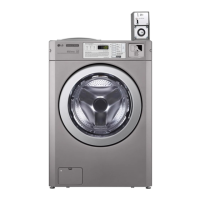15
INSTALLATION INSTRUCTIONS
Connecting the water lines
1
Check the rubber seals on both sides of the
hose.
- Insert a rubber seal into the threaded
fittings on each hose to prevent leaking.
2
Connect the water supply hoses to the HOT
and COLD water faucets tightly by hand and
then tighten another 2/3 turn with pliers.
- Connect the blue hose to a cold water
faucet and the red hose to a hot water
faucet.
4
Connect the hoses to the water inlets tightly
by hand and then tighten another 2/3 turn
with pliers.
- Connect the blue hose to the cold water
inlet and the red hose to the hot water
inlet.
5
Check for leaks by turning on the faucets.
- If water leaks, check steps 1 to 4 again.
3
After connecting inlet hose to water faucets,
turn on the water faucets to flush out foreign
substances (dirt, sand or sawdust) in the
water lines. Let water drain into a bucket,
and check the water temperature.
Cold water
inlet
Hot water
inlet
NOTE
•
For your safety, and for extended product
life, use only authorized components. The
manufacturer is not responsible for product
malfunction or accidents caused by the use
of separately purchased unauthorized parts.
• Use new hoses when you install the washing
machine. Do not reuse old hoses. Use only
the inlet hoses provided with the washer. LG
does not recommend the use of aftermarket
hoses.
• Periodically check the hoses for cracks, leaks
and wear, and replace the hoses every 5
years.
• Do not stretch the water hoses intentionally,
and make sure that they are not crushed by
other objects.
•
Water supply pressure must be
between 1.0 kgf/cm² and 10.0 kgf/
cm² (100~1000 KPa). If the water
supply pressure is more than 10.0
kgf/cm², a pressure reducing valve
must be installed.
• To provide optimum washing performance
the hot water temperature should be set at
120-135°F (48-57°C) and the cold at 60°F
(15°C).
Rubber seal
Water hose
(To water inlet on the
washing machine)
Rubber seal
Water hose
(To faucet)
WARNING
• Do not overtighten. Damage to the cou-
pling can result.
WARNING
• Do not overtighten the hoses.
Overtightening can damage the valves
resulting in leaking and property damage.

